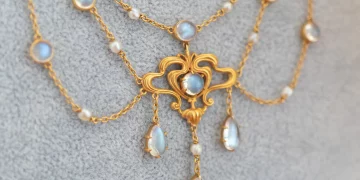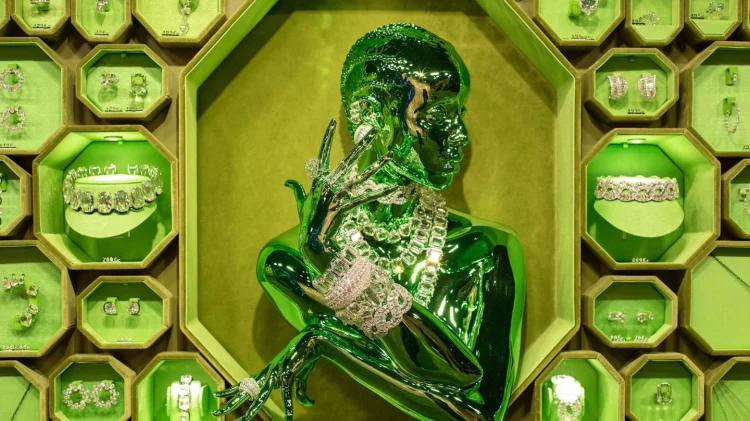Swarovski, a name synonymous with brilliance, luxury, and innovation, is a global leader in the jewelry industry. But its journey to becoming a household name and a symbol of elegance and craftsmanship is far from ordinary. From its humble beginnings in a small workshop in the Austrian Alps to its status today as a multinational jewelry empire, Swarovski’s story is one of vision, resilience, and a relentless pursuit of excellence. So, how did this modest workshop evolve into the world-renowned brand it is today? Let’s take a deep dive into the history and the key factors that contributed to Swarovski’s rise.
1. The Birth of Swarovski: Vision and Innovation
The journey of Swarovski began in 1895 in the small town of Watten in Austria, when Daniel Swarovski, a visionary inventor, established a company that would forever change the world of crystals and jewelry. Daniel, who had a passion for glass cutting, invented a revolutionary technique for creating precise, high-quality crystals, using a machine that allowed for superior cuts compared to anything seen before. This invention would form the foundation of Swarovski’s unique appeal.
1.1 The Innovation of Crystal Cutting
Daniel Swarovski’s vision was rooted in one simple idea: to create perfectly cut crystals that would mimic the brilliance and sparkle of precious gems. He invented a cutting machine that allowed glass to be cut more precisely than ever before. This breakthrough, coupled with his use of lead glass, gave the crystals an incomparable clarity and luster, making them stand out from other glass products.
The quality of Swarovski crystals was so exceptional that the brand quickly gained recognition within the local market. However, what set Swarovski apart was not just the quality of the product, but also Daniel’s vision for mass production. His combination of handcrafting artistry and innovative machinery made Swarovski’s crystals more accessible and less expensive than diamonds, opening up luxury to a broader audience.
2. From Local Workshop to Global Reach: Expanding the Brand
While Daniel Swarovski’s innovative crystal cutting technology was impressive, it was the company’s growth strategy that propelled it onto the world stage. By adapting to trends and embracing new markets, Swarovski was able to expand beyond Austria and establish itself as a global luxury brand.
2.1 Swarovski and the Birth of Fashion Jewelry
In the early 20th century, Swarovski crystals began to be incorporated into fashion jewelry, elevating the brand to new heights. The company quickly realized that their beautifully cut crystals could be used not only for home decor and lighting but also as decorative elements in fashion accessories, such as brooches, earrings, and necklaces.
This was a bold move that allowed Swarovski to tap into the growing demand for affordable luxury. As high-end gemstones like diamonds and rubies were often out of reach for the average consumer, Swarovski’s affordable yet luxurious crystals became the go-to option for people seeking to add a touch of sparkle to their lives without the hefty price tag.
2.2 Early International Expansion
While Swarovski began in a small workshop in Austria, it didn’t take long for the brand to expand internationally. In the 1930s, Swarovski crystals were introduced to the United States and other key markets. The brand’s reputation for quality and brilliance made its pieces particularly popular with American consumers, and Swarovski became a favorite among Hollywood’s elite. In fact, Swarovski crystals were featured in numerous Hollywood films in the 1930s, solidifying the brand’s connection to glamour and luxury.
Swarovski’s ability to adapt to global markets, while maintaining its commitment to craftsmanship, allowed it to become a global brand and an essential name in the world of luxury fashion jewelry.
3. The 1950s: The Rise of the Iconic Swan Logo
Swarovski’s signature swan logo, which has become synonymous with the brand, made its debut in the 1950s, marking a significant milestone in the brand’s evolution. The swan symbolized the elegance and grace that Swarovski’s products conveyed, and it quickly became an iconic image representing luxury, refinement, and beauty.
3.1 Collaborations with Designers and Celebrities
The 1950s and 1960s were pivotal years for Swarovski, as the company began to collaborate with renowned fashion designers and celebrities. These collaborations would help propel the brand into the realm of high fashion and further solidify its place in luxury jewelry.
Swarovski began collaborating with designers like Christian Dior, Balenciaga, and Coco Chanel, incorporating Swarovski crystals into their collections. The use of Swarovski crystals in high fashion helped cement the brand’s status as a top-tier supplier of luxury materials. It was during this time that Swarovski’s name became closely associated with Hollywood glamor and the world of couture fashion.
3.2 The Rise of Swarovski’s Crystal Figurines
In addition to its fashion jewelry, Swarovski’s crystal figurines became a global sensation. These precisely crafted glass sculptures, ranging from animals to characters, helped broaden Swarovski’s appeal, making it not just a jewelry brand, but a luxury home décor brand as well.
The Swarovski crystal figurines became a popular collectible, and by the late 20th century, the brand’s collections were highly sought after by collectors around the world. Swarovski’s ability to diversify its offerings beyond jewelry played a significant role in the brand’s expansion.

4. The 1980s-2000s: Continued Innovation and Corporate Growth
As the years went on, Swarovski continued to grow and evolve. The 1980s and 1990s were marked by technological advancements, innovative marketing, and global expansion.
4.1 The Launch of Swarovski’s Own Jewelry Lines
In the 1980s, Swarovski made a strategic decision to launch its own jewelry lines, featuring its iconic crystals as the central element. The brand began creating its own signature jewelry collections, such as necklaces, bracelets, and earrings, all using Swarovski crystals. These pieces were designed to cater to a broader audience, offering consumers luxury and accessibility at the same time.
Swarovski’s ability to create stunning fashion jewelry using its crystals made it a go-to brand for those looking for affordable luxury. As the demand for Swarovski jewelry grew, the company’s commitment to design innovation and high-quality craftsmanship ensured its place as a global leader in the jewelry industry.
4.2 Expanding into the Global Market
In the 1990s, Swarovski began to broaden its presence in the global market by opening a number of flagship stores in major cities around the world. The Swarovski Crystal Worlds, opened in 1995, became a key element of the brand’s identity, offering a themed museum and a store showcasing the brand’s craftsmanship and innovation.
Swarovski also increased its presence in the luxury watch and home décor sectors, and its products began to appear in luxury retail outlets across the globe, making the brand a true global presence in the luxury market.
5. The Modern Era: Sustainability and Digital Innovation
In the 21st century, Swarovski has not only kept pace with changing trends but has also taken the lead in areas like sustainability, corporate responsibility, and digital innovation.
5.1 A Commitment to Sustainability
As consumers have become more conscious of ethical sourcing and environmental sustainability, Swarovski has responded by adopting more eco-friendly practices. The brand has committed to using sustainable materials and has partnered with various organizations to ensure that its crystals are produced in an environmentally responsible manner.
Swarovski has also launched several initiatives to promote corporate social responsibility and ensure that its business practices align with the growing demand for sustainable luxury.
5.2 Digital Transformation and Online Expansion
Swarovski has embraced digital innovation, using e-commerce platforms and social media to engage directly with its customers. The brand’s online presence has grown exponentially, making its products more accessible to younger generations who are more inclined to shop online.
Through the use of interactive digital marketing and online exclusives, Swarovski has expanded its reach, making it a global digital-first brand while maintaining its physical presence in the luxury retail sector.
6. Conclusion: The Secret to Swarovski’s Success
Swarovski’s evolution from a small Austrian workshop to a global jewelry empire is a story of vision, innovation, and resilience. From the groundbreaking crystal-cutting technique pioneered by Daniel Swarovski to the brand’s strategic collaborations, marketing savvy, and commitment to sustainability, Swarovski’s rise to prominence is a testament to its ability to adapt and evolve while staying true to its core values of quality, creativity, and luxury.
As the brand continues to innovate in the digital age, Swarovski’s enduring success proves that when you combine craftsmanship, innovation, and a strong brand identity, you can not only survive the test of time but thrive in a constantly changing market.

















































